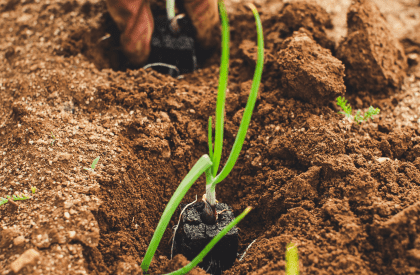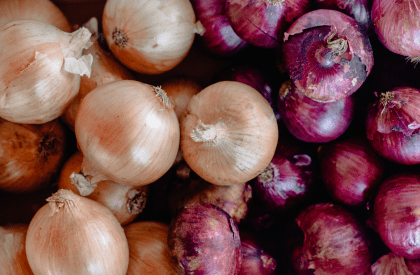-
Colombian Coffee
Colombian Coffee
-
Brazilian Coffee
Brazilian Coffee
-
Pineapple
Pineapple
-
Banana
Banana
-
Olive Oil
Olive Oil
-
Passion Fruit
Passion Fruit
-
Gulupa
Gulupa
-
Granadilla
Granadilla
-
Pitahaya
Pitahaya
-
Gooseberry
Gooseberry
-
Grape
Grape
-
Soursop
Soursop
-
Lulo
Lulo
-
Mango
Mango
-
Tamarillo
Tamarillo
Our Brochures
Contact Us
Social Media


- Botanical Family: Amaryllidaceae.
Climate: Prefers temperate climates but can adapt to a wide range of weather conditions. - Soil: Favors well-drained, fertile soils rich in organic matter with a pH between 6.0 and 7.0.
- Crop Cycle: Between 90 and 150 days depending on the variety and growing conditions.
- Propagation: Through seeds, transplants of young plants, or onion sets.
- xIrrigation: Requires consistent but not excessive irrigation to prevent bulb rot.
Onion varieties
- White Onion: Mild in flavor and primarily used fresh in salads and sandwiches.
- Yellow or Gold Onion: Most common for cooking, adding a rich, sweet flavor to dishes.
- Red Onion: Used both raw and cooked, it has a more pronounced flavor and a color that adds appeal to dishes.
- Green or Spring Onion: Mainly used in salads and as garnishes, they have a milder flavor.
- Purple Onion: With a unique flavor profile and vibrant color, they are excellent for salads and fresh dishes.
common usses
- Culinary: Widely used as a seasoning and foundation in a vast array of dishes worldwide.
- Industry: Utilized in the production of products such as dehydrated soups, powders, and seasonings.
- Gardening: Employed in gardens as an ornamental plant and to repel certain pests.
The production process
onion
1. Variety Selection and Soil Preparation
- Variety choice: Based on the climatic and soil conditions of the region.
- Soil preparation: Deep tilling to allow good root development, incorporation of organic matter, and pH adjustment between 6.0 and 7.0.
2. Planting
- Planting season: Depending on the climate and the chosen variety, it can be planted at different times of the year.
- Type of planting: It can be direct (sowing seeds in the definitive ground) or transplanting seedlings previously germinated in a nursery.
3. Care During Growth
- Irrigation: Maintain constant moisture but without waterlogging to avoid fungal diseases.
- Weed control: Perform weeding tasks or use specific herbicides.
- Fertilization: Apply fertilizers rich in nitrogen, phosphorus, and potassium according to the crop’s needs.
4. Pest and Disease Management
- Common pests: Thrips, nematodes, and mites are some of the pests that can affect the crop.
- Common diseases: Downy mildew, white rot, and fusarium are typical diseases in onion cultivation.
- Control: Implement preventive measures and, if necessary, use specific phytosanitary products.
5. Harvest
- Optimal moment: When the foliage begins to yellow and fall, generally between 90 and 150 days after planting.
- Collection: Carry it out manually or using specific machinery to avoid damaging the bulbs.
6. Post-harvest and Storage
- Curing: Leave the onions in the sun for a few days so that the bulbs cure and the skin hardens.
- Storage: Store in a cool, dry, and well-ventilated place to avoid disease proliferation and decomposition.
7. Marketing
- Packing: Select, clean, and pack the onions for sale.
- Sale: Distribute to local or international markets depending on the scale of production.
Places Where It Is Grown
- Americas
- United States: The main producing states include California, Texas, and Washington.
- Mexico: It is cultivated in various states, including Baja California, Chihuahua, and Puebla.
- Argentina: Provinces like Mendoza, Buenos Aires, and San Juan are significant regions for onion cultivation.
- Brazil: It is grown in states such as São Paulo, Minas Gerais, and Goiás.
- Asia
- China: It is the largest onion producer globally, cultivating them in various provinces.
- India: Another significant onion producer, with major cultivation in states such as Maharashtra, Gujarat, and Madhya Pradesh.
- Japan: While not a large producer, it mainly cultivates onions in Hokkaido and the Tohoku region.
- Europe
- Spain: One of the major producers in Europe, with significant production in regions like Castilla-La Mancha and Valencia.
- The Netherlands: A substantial producer and exporter, especially in the provinces of Flevoland and Noord-Holland.
- Russia: Primarily produces onions in the southern and southwestern parts of the country.
- Africa
- Egypt: The main producer in Africa, growing them mainly in the Nile Delta and Upper Egypt regions.
- South Africa: The Western Cape and Limpopo provinces are significant onion-producing regions.
- Oceania
- Australia: The regions of Tasmania, South Australia, and Queensland are primary areas for onion cultivation.
- Middle East
- Iran: A significant producer in the region, cultivating onions mainly in the northern and northwestern provinces.
Medicinal Uses
- Anti-inflammatory: Contains anti-inflammatory properties that can help reduce inflammation.
- Immune System: The vitamin C content can help boost the immune system.
- Cardiovascular Health: May help lower cholesterol levels and enhance cardiovascular health.
- Digestion: The fiber present in onions can aid in improving digestion.
